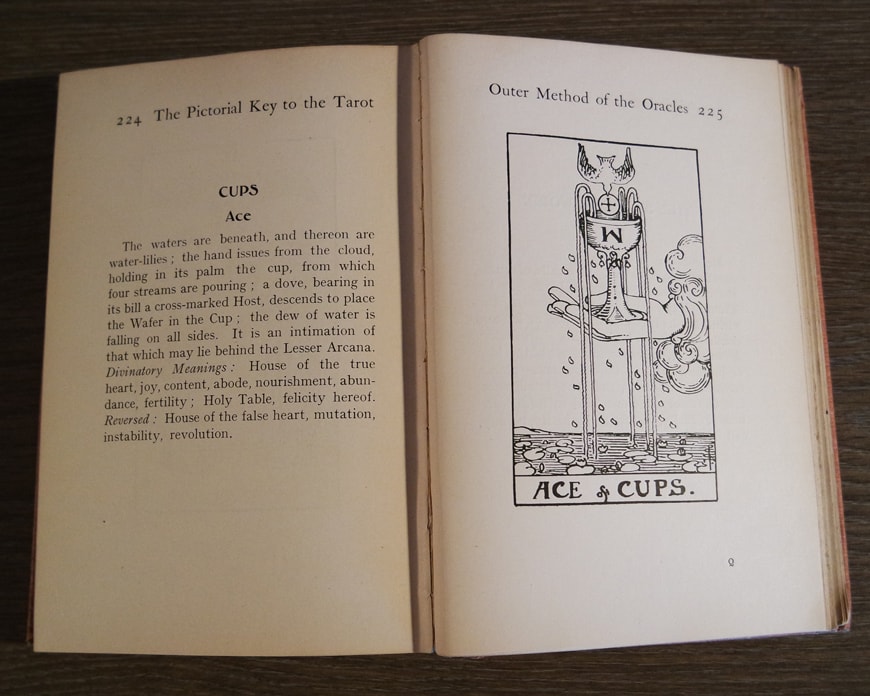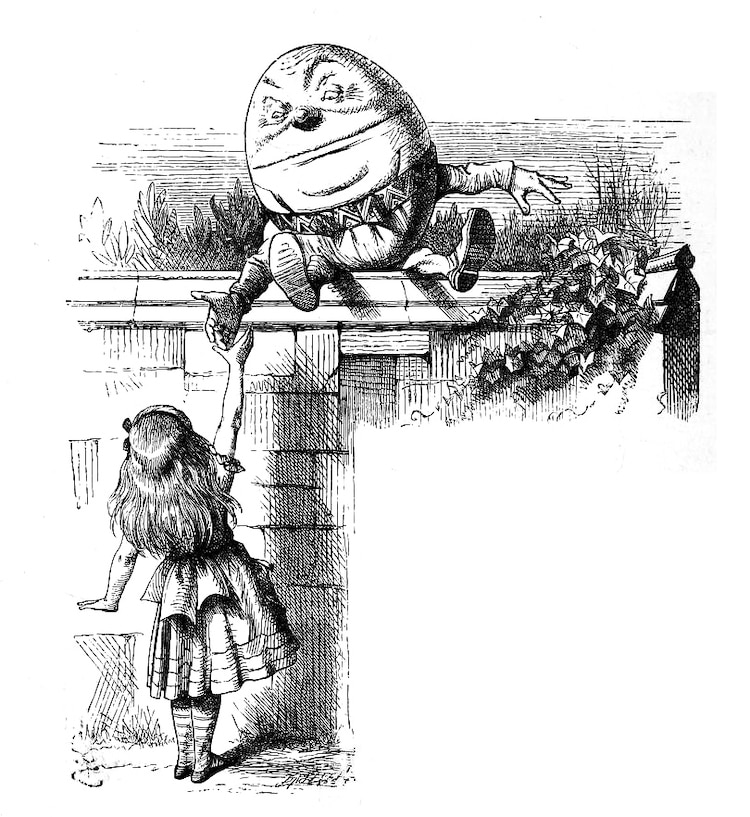Deliberately creating mental-entities; chunks
I've been thinking about how to deliberately create mental tools to think (better) with. I don't have a recipe yet, but I think there's some value to creating mental entities to think of, even if they are not necessarily tools.
I want to point to a line, and I'm going to do it by pointing to two points on that line:
- "The Pictorial Key To The Tarot". This is a book (and a type of book) which contains the illustrations of the cards (by Pamela Colman Smith) paired with text (by Arthur Waite) about what is depicted in the illustrations. The text can be literal. For example, you can see the water lilies in the Ace of Cups illustration, and "water lilies" are mentioned in the text. The text can also add additional symbolic or nonliteral elements. This book, or books like it, were and are distributed as little white books along with Tarot decks.

- "Mind Fields" by Jacek Yerka and Harlan Ellison. This is a book consisting of surreal paintings (by Yerka) paired with very short stories (by Ellison) that were inspired by those surreal paintings.

The generalization that I'm trying to point to is "books consisting of illustrations aligned with parallel text describing and elaborating on the illustrations". The activity of going back and forth between reading the (cryptic, surreal, elliptical...) words and examining the (cryptic, surreal, elliptical..) picture is more compelling than reading the words or looking at the illustrations alone. (See "Puzzle Theory" by Sarah Perry and "Understanding Comics" by Scott McCloud.) Possibly "Masquerade" by Kit Williams, "MAZE" by Christopher Manson, "The Ultimate Alphabet" by Mike Wilks, "Animalia" and "The Eleventh Hour" both by Graeme Base are other examples.
We humans have various faculties. Certainly eyes and ears, but also more abstract mental organs. The phonological loop is in some sense adjacent to the sense of hearing, but it is a distinct capability than hearing. The mind's eye, mental canvas, or visual imagination is similarly adjacent to the sense of sight, but again it is a distinct capability than any of sight, hearing or the phonological loop. By reading, we can have an internal experience somewhat like listening to the author speaking to us. Alternating reading the words and looking in the picture for corresponding elements, sloshes a mental entity (such as the lilies in the Ace of Cups, or the Ace of Cups as an entire scene), from the domain of one mental organ to another. This sloshing of ideas from one mental space to another can act like a rock polisher, creating a rounded, polished mental thing that you can eventually directly think of, as opposed to laboriously building it feature by feature.

(See "The Magical Number Seven, Plus or Minus Two" by George Miller, the academic paper which established the idea of "chunking" in cognitive psychology)
If you have played Supergiant's Hades, you likely have one of these rounded, polished, mental entities in your mind already, the idea of Poseidon as he appears in that game. There's a symbol, the trident, which appears glowing when you are about to receive a boon from him, and also over doors which lead to rooms on the path to receive a boon from him. The trident has a color, blue, and the boons that you receive often have a particle effect, which is that same color. The character has an illustration, which you could imagine, and you can bring to mind the vocal qualities of the voice acting, or the personality depicted by Poseidon's lines. Poseidon's arrival, and his powers when you activate them, has a splash sound effect. The boons that Poseidon grants have a commonality - they generally give knockback, and unlike other effects that give knockback, Poseidon's boons work on armored opponents as well, and you can think of that pattern. You may have a valuation of Poseidon's boons, an overall preference for or against them, or you may be able to weigh the utility Poseidon's boons against another deity's boons. Poseidon is the main character's uncle, and is part of the Olympian faction within the game - so he has a friendly rivalry with Zagreus's other uncle, Zeus, and a somewhat oppositional relationship with Zagreus's father, Hades.

For most of the deities in Supergiant's Hades, there are all of these different facets:
- a glyph,
- a characteristic color,
- a visual image,
- vocal qualities, barks, and a characteristic sound effect,
- abstract facts regarding that deity and/or that deity's boons,
- valuation or weight relative to other deities and/or other deities's boons,
- sense of personality,
- relationship to the main character and the social network,
This structure makes me think about Giordano Bruno's "On the Shadows of Ideas". I have not read it, only secondary sources describing it, but I believe he recommends creating mental entities like Poseidon, and lists lots of images. This is an excerpt of a translation, taken from "Giordano Bruno and the Hermetic Tradition" by Frances Yates, which I am reading now. I believe "On the Shadows of Ideas" goes on and on like this.
An image of Saturn. A man with a stag's head, on a dragon, with an owl which is eating a snake in his right hand.
I think (and I'm not sure what Giordano Bruno thought) that these vivid particulars are in some sense arbitrary. It is perhaps difficult to express in what sense the particulars of these entities are arbitrary. It is similar to the arbitrarity of language. Our voices can create a variety of sounds, phonemes. Different languages have - arguably, are - different mappings between sounds and meanings. Prior to choosing a particular language, there is a freedom to, in principle, map any sound to any meaning and vice versa. This is the precise freedom that conlang authors enjoy. However, in contrast, poets working within a particular language can (must) accomplish their poetry without using that freedom.
An illustrative counterexample to the distinction between the conlang author and the poet is Lewis Carroll's Humpty Dumpty. "When I use a word," Humpty Dumpty said, in rather a scornful tone, "it means just what I choose it to mean - neither more nor less." "The question is," said Alice, "whether you can make words mean so many different things."

Bruno, or a mnemonist working according to Bruno's techniques, is first the conlang author and later the poet. During the mental-entity creation process, they meditate to create these mental-entities. During the meditation, the mnemonist is "sloshing" the rough mental-entity from one faculty to another. From phonological loop to mental canvas: reading or reciting descriptions of vivid scenes to themselves and painting the corresponding features in their mind's eye. From mental canvas to phonological loop: mentally viewing a vivid scene and describing it in serial mental speech.
If there is some detail which "happens to happen" in the course of visualizing they have the conlang author's freedom to bake that detail into the mental-entity. For example, after visualizing "a man carrying a snake", and then asking, "is he carrying the snake in his left or right hand?" they might be able to consult their mental image and give a definite reply. This gradual accretion of elaborated detail might characteristically yield these surreal, dreamlike, symbolic, and/or esoteric images.
Some of Bruno's images were copied from other sources, such as "De occulta philosophia" by Agrippa. He might have copied all of his images. However, whether it was Bruno or someone else, someone must have invented these images at some point. I'd like to get into that image-inventor's mindset. It might be that someone did it with an attitude of deliberate deceit, saying to themselves "I'm going to write a book of fake spells, attribute it to Hermes Trismegistus, and sell it to a credulous fool." It might be that someone wrote sincerely, either via some sort of aleatoric divination procedure, or documented sincerely experienced visions, possibly via fasting or drugs.
However, my personal preference is to imagine that this stuff is essentially fanfiction. When you write texts like "On the Shadows of Ideas", Hermes Trismegistus is sortof everyone's property, in the same way that Bella Swan or Harry Styles is sortof everyone's property. Fanfiction authors write these characters doing the kind of things that fanfiction authors want to write about (such as magic, or kissing), and fanfiction readers choose which texts to read based on their (anticipated) contents (such as magic, or kissing).


Fanfiction is not a telephone book, where the primary utility of it is that you can use it to call people. Almost all of the writers and readers are in on this "secret" and therefore you rarely see disclaimers at the front of fanfiction saying "This is a work to be evaluated solely on its contents and not on any practical or mundane correspondence between its contents and the world. In particular, none of Hermes, Bella, or Harry are real people; please do not call any phone numbers that are mentioned to be theirs within this document, and furthermore they never actually kissed."
There is a later step, when the mnemonist wants to use their collection of carefully cultivated mental-entities to accomplish something, such as to quickly memorize a sequence of things. If I understand correctly this works by the mnemonist combining each of the items to be memorized with the standard sequence of carefully cultivated scenes - so if the first item in the series is an ox (or the letter A, which might be routinely mapped to an ox by the mnemonist), then perhaps briefly visualizing the ox charging and impacting the man in the image of Saturn is enough that, when it comes time for the mnemonist to recall what the first item in the item is, they can think of Saturn, and remember their combination, something like "Oh right, I remember that Saturn was recently hit by an ox", and therefore infer that the first item was an ox. At this later step, the mnemonist has the freedom of the poet, to choose precisely how to combine the particulars of their mental-entities with the item to be memorized to form a memorable, vivid, union.
I am not much interested in the use (or to say it another way, the utility) of this "deliberate sloshing" or "memory re-encoding" for the narrow purpose of feats of memorization. Rider was a company that made money by printing and selling Tarot card decks accompanied by "key to the tarot" books, and that profit motive is an example of a non-memorization utility. People bought them because they found them fascinating, or for fortune telling, not as memory aids; those are further examples of non-memorization utility. Similarly, Jacek Yerka and Harlan Ellison and their publisher probably created Mind Fields for some combination of art and bills.
If I understand correctly, Giordano Bruno was explicitly claiming that this technique could be used for feats of memory. When I put Bruno beside Smith, Waite, Ellison, and Yerka, it's clear that he's in the minority, and many people create this kind of thing without the purpose of using them for feats of memory.
It might simply be pleasurable to create novel symbols to think with. Whether pleasure, fascination, art, magic, memory, strengthening exercise of one mental faculty or another, I suspect all of these claims regarding the utility of this practice could be after-the-fact confabulations. That is, someone might stumble upon on this thing they can do with their mind - this rock-polishing mental-entity-creation meditative practice - and, when they are pushed by circumstances to justify it, they might leverage it in order to make money by selling art inspired by their images or they might rationalize it as perhaps having some vague beneficial effect, on the mind or the faculty of imagination or memory or something magical.
Without focusing on the utility of this practice for any particular purpose, one can simply say "It is possible, by this technique, to create new mental-entities for oneself". This non-utility stance is more interesting, and leads to a different set of activities, naturalistically investigating "what has happened in the past?", and "what is possible?", and "what is going on?", rather than taking one or another person's explanation as "the" utility of doing this practice.